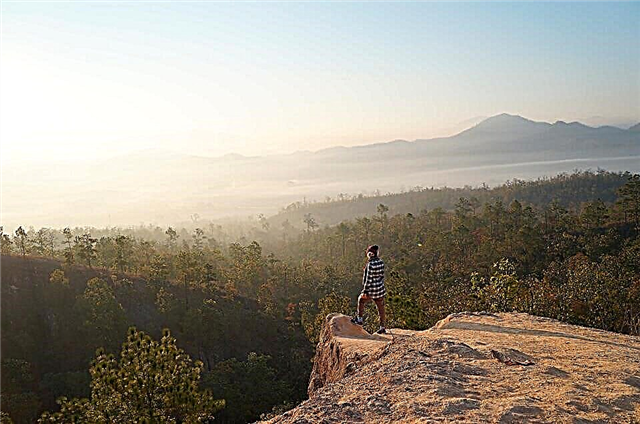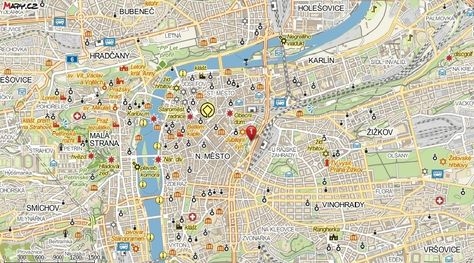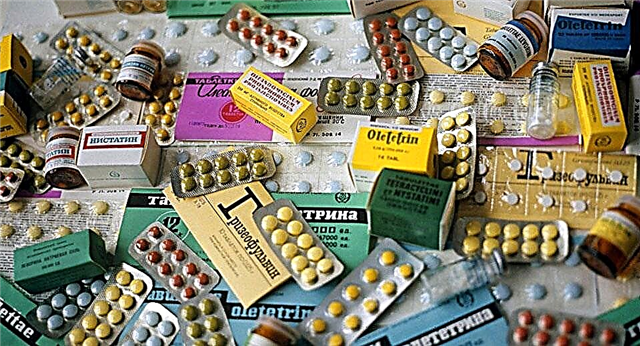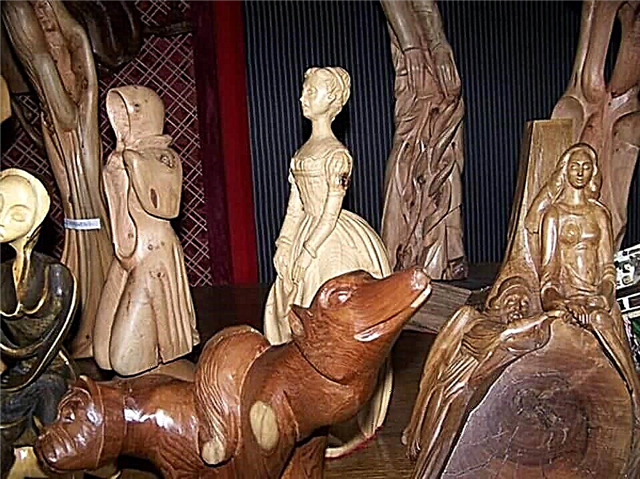In the north of our country, next to Finland, there is a region that is very popular with tourists. People come to Karelia at any time of the year. In summer, it attracts water tourists, lovers of mushroom and berry places. Travelers are attracted by wooden temples, noisy waterfalls and ancient petroglyphs. In winter, people go to the republic to take a steam bath in a Russian bath, go skiing and snowmobiling.
Climate
Karelia is good for its mild climate. Winter on the northern land is free from severe frosts, and summers are moderately warm. However, from time to time, there are several hot days when the temperature rises slightly above + 25 ° C. Due to the influence of the northern seas, the Karelian heat is felt quite strongly. Local residents are ready for anything, so in the middle of summer, when they leave their homes, they take with them an umbrella, jacket and sunglasses.

Kizhi Pogost - right: left: Church of the Intercession of the Most Holy Theotokos, Church of the Transfiguration of the Lord
There is a lot of snow in Karelia during the cold season. The thermometer column rarely drops below -25 ° C. During the day, usually -5 ... -7 ° С, and at night up to -10 ° С. Short-term thaws alternate with frosts.
Cities
The capital of the republic, Petrozavodsk, is the largest city in the region with three hundred thousand meters. The rest of the Karelian cities are smaller. Kondopoga, Kostomuksha and Segezha are home to 30 thousand people, and small towns like Belomorsk, Kem and Olonets have from 7.2 to 18.8 thousand inhabitants.

Kivach waterfall on the Suna river
Tourist opportunities
There are asphalted roads in Karelia, but due to the small population there are relatively few of them. By trains you can get to Petrozavodsk and to the major cities of the republic. River ships and planes fly here. There is a hope that the Petrozavodsk airport will turn into an international airport and will receive flights from abroad.
Thanks to the beautiful nature, tourism in Karelia is better developed than in other regions of Russia. Especially many tourists come to the republic to travel along the picturesque lakes and rivers. It is easy to lay water routes of varying length and difficulty here. Karelia is rich in calm rivers for family rafting and rivers with dangerous rapids.

Waterfall "White Bridges" (Yukankoski) on the river Kulismayoki
Most water tourists travel on the rivers Suna, Syapsya, Shuya, Syamozero and Shotozero. Picturesque places are loved for crystal clear water, convenient parking and pine-covered shores.
Many people go to the powerful Kivach waterfall. Fortunately, the road to it from Petrozavodsk takes only 1.5-2 hours. The extinct volcano Girvas enjoys no less attention. When water is drained from the local hydroelectric power station, a huge waterfall forms in the channel of the Suna. Foamy water roars down three steps, the total height difference at which reaches 30 m.
A large flow of travelers happens to the Ruskeala marble quarry. Once upon a time, valuable finishing stone was mined here, but now the clear lake and steep cliffs are eager to see fans of extreme tourism. In the mountain park, people can hike, go boating and go diving. The most fearless cross the canyon on a rope bridge or ride a troll.

Ruskeala Mountain Park
Dirt roads and paths attract cycling enthusiasts to Karelia. Cycling tours for 3-7 days are conducted around the republic - around Ladoga, along the Rybachy peninsula and to the mystical mountain Vottovaara. Their participants visit ancient villages, get acquainted with nature reserves, folk crafts and masterpieces of Karelian architecture. Some tourists travel to the republic with their own bicycles, while others rent light transport on site.
If you like horses, you can opt for a horse tour. Such trips are carried out at any time of the year - both in summer and in winter. The most popular are the horseback trail around Syamozero and horseback riding tours in the taiga. Horseback riding trips are organized in deserted places. Tourists enjoy horseback riding, live in tents or guest houses, visit natural monuments, pick berries and mushrooms.

Kivakkakoski waterfall
Those who prefer to admire the Karelian nature with comfort choose cruise tourism. During navigation, motor ships run along the Onega and Ladoga lakes. Fans of excursion tourism love Petrozavodsk, Kizhi, Marcial Waters, Sortavala and other historical places of the republic.
Petroglyphs
Travelers are in demand for routes to ancient petroglyphs. Many unique rock carvings are located in the Pudozh region, on the eastern bank of Onega. Most of them date back to the 4th-3rd millennia BC.

Onega petroglyphs
An interesting group of petroglyphs is located near the mouth of the Vyg River, not far from Belomorsk. Realistic rock carvings are scattered over an area of 20 square meters. km. It is curious that it was here that a drawing of a prehistoric man standing on skis was found. Some petroglyphs are very small, others reach 2.5 m in size.
Images on granite stones are of great scientific, historical and artistic value. Not only tourists come to see them, but also professional researchers - historians, ethnographers, art historians and archaeologists. Onega petroglyphs are included in the UNESCO World Heritage List and are under special protection of the state. They are available after the end of the spring flood, that is, with the onset of summer.

Archaeological complex "White Sea Petroglyphs"
Architectural monuments
There are many places in the republic where one can touch the past of our country, therefore lovers of architecture and history willingly go to Karelia. On Lake Onega, 68 km from Petrozavodsk, there is a museum-reserve with unique wooden buildings. The pearls of Kizhi are the 22-domed Church of the Transfiguration, the Intercession Church, the Chapel of the Archangel Michael and old residential buildings. In the summer they come to the island by water transport, and in the winter they get to the off-road vehicle-pneumatic all-terrain vehicle.
Many tourists visit Valaam monastery, which is located in the north of Lake Ladoga. The monastic monastery has an ancient history, the status of the spiritual center of the North of Russia and the main holy place in Karelia. Translated from the Finnish language "Valaam" means "high land". Indeed, the monastery and hermitages rise above the surface of the lake, and they can be seen from everywhere.

Valaam Spaso-Preobrazhensky Monastery
Monuments of wooden architecture have been preserved in many Karelian villages. In the Veps village of Sheltozero, you can see a two-storey log house of the 19th century, in which an ethnographic museum is now open. People come to Kinerma to look at the chapel of the Smolensk Mother of God of the 18th century, peasant huts and baths of the 19th century. The village of Virma is famous for the church of Peter and Paul of the 17th century and the remains of the saltworks of the 16th-17th centuries, which belonged to the Solovetsky monastery, and Vegoruksa - a remarkable monument of Zaonezh architecture - the Church of St. Nicholas the Wonderworker of the 18th century.
Everyone who wants to see the temple built according to the drawings of Peter the Great travels to the Marcial Waters. The wooden church of St. Peter the Apostle appeared at the first Russian resort in 1721. Nearby, in the former house of the caretaker, an interesting museum has been opened.

Svyato-Ilyinsky Vodlozersky churchyard
To learn about the tragic pages of the history of the Soviet-Finnish war, it is worth paving a route through the Suoyarovsky district of Karelia. A large military memorial complex has been built on the heights of Kollasjärvi. The wooded hills keep trenches, bunkers, dugouts, dugouts, trenches, mass graves and other evidence of fierce battles on the Karelian Isthmus. The memorial festival "Karelian Frontiers" is held here every March.
Connoisseurs of contemporary art are delighted with the Onega embankment in Petrozavodsk.Coastal Street is a real open-air museum, where unusual sculptures are exhibited. Many of them were donated to the capital of Karelia by twin cities.

Church of the Epiphany in the village of Chelmuzhi
Rest in winter
When snow falls on the Karelian expanses, connoisseurs of good skiing come to the republic. There are excellent tracks in Petrozavodsk itself. Interesting ski routes and tours are organized in other places of Karelia.
Want to go snowmobiling? You are welcome! In Karelia, this is one of the most demanded entertainments in winter. Snowmobile tours are offered at most camp sites and holiday homes. They are conducted by experienced mechanic instructors, so tourists can only stock up on warm clothes and shoes, as well as not forget to take a good mood and cameras on the road.

Sheltozersk Vepsian Ethnographic Museum
Several husky kennels have been established in Karelia. Those who come to Petrozavodsk for winter holidays can visit sled dogs, chat with huskies and, if desired, ride a dog sled.
Any trip through the Karelian forest in winter is fascinating. Unlike large cities, there is a lot of snow in the republic, and it sparkles in the sun. The trees are covered with powerful white caps. The trails of animals are visible on the snowdrifts. Hares, foxes, squirrels, moose and lynx left their tracks.
Fishing

Chapel of the Smolensk Mother of God in Kinerma
Many travelers associate Karelia with good bite and a wonderful aroma of fish soup cooked on a fire. Karelian reservoirs rarely warm up above + 25 ° С, therefore cold-resistant and deep-sea fish love them. Fishing is practiced here all year round, with the exception of November and spring spawning.
In the fall, many fish on the lakes. During the summer, the fish gains weight and becomes very active. Pike perch, bream, bream, burbot, burbot, chub, pike, whitefish, perch, roach and ide are good for biting. The winter fishing season runs from December to early May. Fishermen catch with girders, winter fishing rods and never go without a catch. Most of all they manage to catch before the beginning of January. On the first ice, there is still a lot of oxygen in the water, so the fish can be very mobile.

Church of Peter and Paul in Wyrm
Souvenirs
What to bring from a trip to Karelia? One of the most popular souvenirs is crafts made from the famous Karelian birch. The unusual patterned texture gives the wooden souvenirs a special warmth. True, you need to keep in mind that they are expensive. Prices for the simplest writing instruments start at 500 rubles, and for a small box they ask for three times more.
Black shungite is mined in the republic, and jewelry and cosmetics from healing rocks are used here. In souvenir shops there are beads, bracelets, pendants, watches, face creams, masks and shungite shampoos. All of them are in great demand among visitors.

Church of St. Peter the Apostle in the village of Marcial Waters
A very nice memorable gift - products made of light birch bark. Karelian craftsmen know how to weave beautiful baskets and tuesques, make graceful hairpins, neat frames for photos and mirrors, jewelry boxes and key rings.
Travelers willingly take folk amulet dolls, photo albums and plates with views of Karelian sights. Many people like souvenirs made of stone, wood and ceramics, multicolored embroidery and patchwork. Talented masters live in Karelia, whose works of authorship can be safely attributed to real works of art.

View of Kizhi on Lake Onega
Tasty jam made from Karelian berries is popular among delicious souvenirs. The price for a can of sweet cranberry, blueberry or cloudberry treats starts from 200 rubles. Aromatic tinctures and balms are made from berries in Karelia. 0.5 liter bottles cost from 400 rubles.











